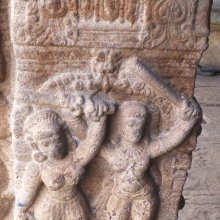Varahavatara, Varāhāvatāra, Varaha-avatara: 6 definitions
Introduction:
Varahavatara means something in Hinduism, Sanskrit. If you want to know the exact meaning, history, etymology or English translation of this term then check out the descriptions on this page. Add your comment or reference to a book if you want to contribute to this summary article.
Images (photo gallery)
In Hinduism
Purana and Itihasa (epic history)
Source: archive.org: Nilamata Purana: a cultural and literary studyVarāhāvatāra (वराहावतार) refers to the “boar incarnation” of Viṣṇu and was once depicted and worshipped in ancient Kashmir (Kaśmīra) as mentioned in the Nīlamatapurāṇa.—Viṣṇu as boar, says the Nīlamata, lifted up the earth with his tusk and tore the mountains to pieces. Varāhatīrtha is mentioned frequently and a visit to it is described as the giver of the merit of performing Rājasūya sacrifice.

The Purana (पुराण, purāṇas) refers to Sanskrit literature preserving ancient India’s vast cultural history, including historical legends, religious ceremonies, various arts and sciences. The eighteen mahapuranas total over 400,000 shlokas (metrical couplets) and date to at least several centuries BCE.
Shilpashastra (iconography)
Source: Shodhganga: The significance of the mūla-beras (śilpa)Varāhāvatāra (वराहावतार) or Varāha is one of the daśāvatāra (ten incarnations) of Viṣṇu, is found depicted at the Kallazhagar Temple in Madurai, which represents a sacred place for the worship of Viṣṇu.—[in Varāhāvatāra,] Viṣṇu took the form of a boar. He is represented with a boar’s head holding Bhūdevī seated on his knee.

Shilpashastra (शिल्पशास्त्र, śilpaśāstra) represents the ancient Indian science (shastra) of creative arts (shilpa) such as sculpture, iconography and painting. Closely related to Vastushastra (architecture), they often share the same literature.
Natyashastra (theatrics and dramaturgy)
Source: Shodhganga: Elements of Art and Architecture in the Trtiyakhanda of the Visnudharmottarapurana (natya)Varāhāvatāra (वराहावतार) refers to one of the Daśāvatāra (“ten incarnations”) (of Lord Viṣṇu) to which are assign various hand gestures (in Indian Dramas), according to the Viṣṇudharmottarapurāṇa, an ancient Sanskrit text which (being encyclopedic in nature) deals with a variety of cultural topics such as arts, architecture, music, grammar and astronomy.—The varāha kind of incarnation of lord Viṣṇu denotes that avatāra, when lord Viṣṇu transforms to the shape of a varāha i.e., a boar. In the Viṣṇudharmottarapurāṇa varāhāvatāra is suggested to show with the śikharahasta where the little finger is extended. But the Abhinayadarpaṇa suggests to keep both hands in mṛgaśīrṣahasta and place above another and the thumb of one hand meets that of the other. Point to be noted here is that as said in the Viṣṇudharmottarapurāṇa, if the little finger is extended in śikharahasta, this hand gesture is looked like as it is of mṛgaśīrṣa-hasta. So, from this point of view, it can be said that the suggestion of the Viṣṇudharmottarapurāṇa and the Abhinayadarpaṇa regarding the hastamudrā of Varāhāvatāra is quite similar.

Natyashastra (नाट्यशास्त्र, nāṭyaśāstra) refers to both the ancient Indian tradition (shastra) of performing arts, (natya—theatrics, drama, dance, music), as well as the name of a Sanskrit work dealing with these subjects. It also teaches the rules for composing Dramatic plays (nataka), construction and performance of Theater, and Poetic works (kavya).
Languages of India and abroad
Sanskrit dictionary
Source: DDSA: The practical Sanskrit-English dictionaryVarāhāvatāra (वराहावतार).—the boar or third incarnation of Viṣṇu.
Derivable forms: varāhāvatāraḥ (वराहावतारः).
Varāhāvatāra is a Sanskrit compound consisting of the terms varāha and avatāra (अवतार).
Source: Cologne Digital Sanskrit Dictionaries: Monier-Williams Sanskrit-English DictionaryVarāhāvatāra (वराहावतार):—[from varāha] m. the boar-incarnation (in which Viṣṇu, in boar-form, raised up on one of his tusks the earth which lay buried beneath the waters when the whole world had become one ocean), [Indian Wisdom, by Sir M. Monier-Williams 327; Religious Thought and Life in India 102.]
Sanskrit, also spelled संस्कृतम् (saṃskṛtam), is an ancient language of India commonly seen as the grandmother of the Indo-European language family (even English!). Closely allied with Prakrit and Pali, Sanskrit is more exhaustive in both grammar and terms and has the most extensive collection of literature in the world, greatly surpassing its sister-languages Greek and Latin.
Kannada-English dictionary
Source: Alar: Kannada-English corpusVarahāvatāra (ವರಹಾವತಾರ):—
1) [noun] the third of the ten incarnations of Viṣṇu, in which he took the form of a wild boar.
2) [noun] Viṣṇu, who took this form.
Kannada is a Dravidian language (as opposed to the Indo-European language family) mainly spoken in the southwestern region of India.
See also (Relevant definitions)
Partial matches: Varaha, Avatara.
Full-text: Varaha, Varah-avatar, Boar, Dashavatara, Purana.
Relevant text
Search found 8 books and stories containing Varahavatara, Varāhāvatāra, Varaha-avatara, Varāha-avatāra, Varahāvatāra; (plurals include: Varahavataras, Varāhāvatāras, avataras, avatāras, Varahāvatāras). You can also click to the full overview containing English textual excerpts. Below are direct links for the most relevant articles:
Vishnudharmottara Purana (Art and Architecture) (by Bhagyashree Sarma)
2.2. (d): Hand Gestures for Daśāvatāra < [Chapter 3 - Drama and Dance]
The Vishnu Purana (by Horace Hayman Wilson)
10. The Brahma-vaivartta Purāṇa < [Preface]
Chapter XXIX - Slaughter of demon Naraka < [Book V]
Chapter IV - Narayana appearance, in the beginning of the Kalpa, as the Varaha (boar) < [Book I]
Sripura (Archaeological Survey) (by Bikash Chandra Pradhan)
Stone Images (3): Vaisnava Images < [Chapter 3 - Sculptural Programme]
Tiruvaymoli (Thiruvaimozhi): English translation (by S. Satyamurthi Ayyangar)
The Matsya Purana (critical study) (by Kushal Kalita)
Part 1.3 - Incarnations of Viṣṇu < [Chapter 4 - Religious aspects of the Matsyapurāṇa]
Puranic encyclopaedia (by Vettam Mani)
Related products

